Public Health: Analysis of Disease Control Strategies and Priorities
VerifiedAdded on 2023/04/20
|24
|6817
|471
Report
AI Summary
This report delves into the core principles of public health, defining its role in protecting and improving community health through lifestyle promotion, disease surveillance, and response. It examines the roles of key organizations like the World Health Organization (WHO), Public Health England (PHE), and local authorities in identifying health issues and implementing control strategies. The report analyzes the epidemiology of HIV and breast cancer in the UK, including prevalence, incidence, and mortality rates, and evaluates the effectiveness of various disease control strategies such as screening, immunization, surveillance, and health education. Furthermore, it explores the current priorities and approaches in providing services for people with HIV and breast cancer, focusing on prevention strategies like pre-exposure prophylaxis and the use of antiretroviral therapy. The report provides an overview of the challenges and successes in public health interventions, emphasizing the importance of a multi-faceted approach to disease control and health promotion.
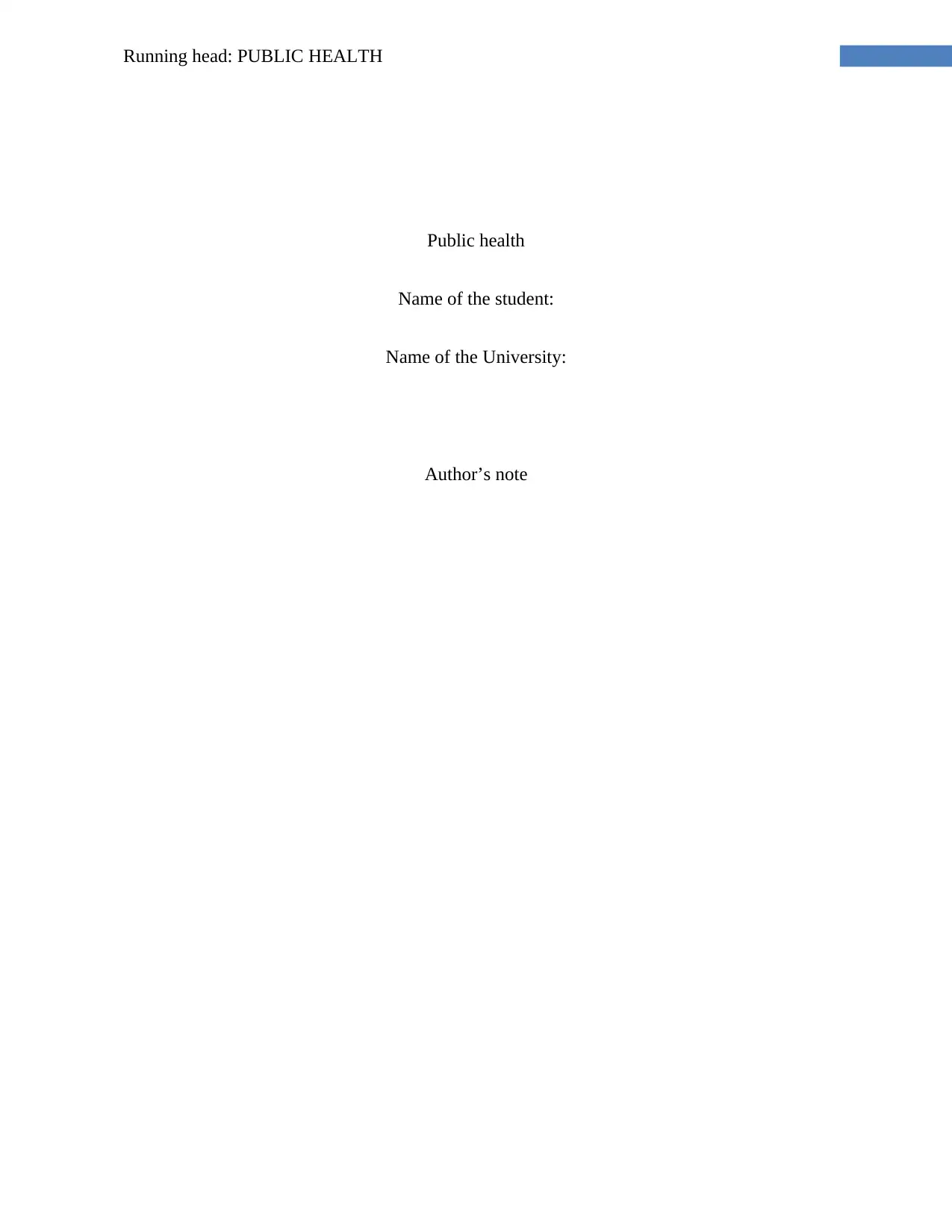
Running head: PUBLIC HEALTH
Public health
Name of the student:
Name of the University:
Author’s note
Public health
Name of the student:
Name of the University:
Author’s note
Paraphrase This Document
Need a fresh take? Get an instant paraphrase of this document with our AI Paraphraser
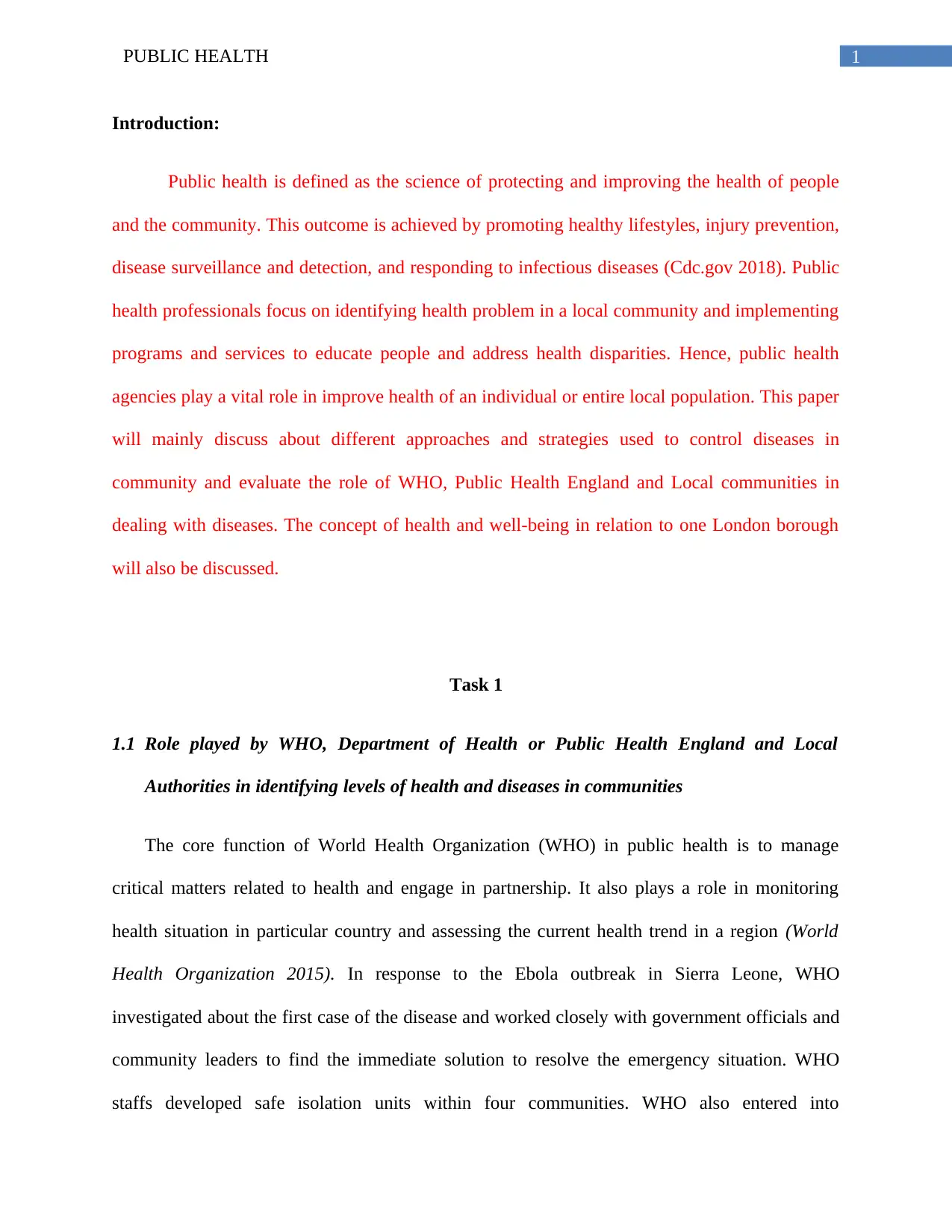
1PUBLIC HEALTH
Introduction:
Public health is defined as the science of protecting and improving the health of people
and the community. This outcome is achieved by promoting healthy lifestyles, injury prevention,
disease surveillance and detection, and responding to infectious diseases (Cdc.gov 2018). Public
health professionals focus on identifying health problem in a local community and implementing
programs and services to educate people and address health disparities. Hence, public health
agencies play a vital role in improve health of an individual or entire local population. This paper
will mainly discuss about different approaches and strategies used to control diseases in
community and evaluate the role of WHO, Public Health England and Local communities in
dealing with diseases. The concept of health and well-being in relation to one London borough
will also be discussed.
Task 1
1.1 Role played by WHO, Department of Health or Public Health England and Local
Authorities in identifying levels of health and diseases in communities
The core function of World Health Organization (WHO) in public health is to manage
critical matters related to health and engage in partnership. It also plays a role in monitoring
health situation in particular country and assessing the current health trend in a region (World
Health Organization 2015). In response to the Ebola outbreak in Sierra Leone, WHO
investigated about the first case of the disease and worked closely with government officials and
community leaders to find the immediate solution to resolve the emergency situation. WHO
staffs developed safe isolation units within four communities. WHO also entered into
Introduction:
Public health is defined as the science of protecting and improving the health of people
and the community. This outcome is achieved by promoting healthy lifestyles, injury prevention,
disease surveillance and detection, and responding to infectious diseases (Cdc.gov 2018). Public
health professionals focus on identifying health problem in a local community and implementing
programs and services to educate people and address health disparities. Hence, public health
agencies play a vital role in improve health of an individual or entire local population. This paper
will mainly discuss about different approaches and strategies used to control diseases in
community and evaluate the role of WHO, Public Health England and Local communities in
dealing with diseases. The concept of health and well-being in relation to one London borough
will also be discussed.
Task 1
1.1 Role played by WHO, Department of Health or Public Health England and Local
Authorities in identifying levels of health and diseases in communities
The core function of World Health Organization (WHO) in public health is to manage
critical matters related to health and engage in partnership. It also plays a role in monitoring
health situation in particular country and assessing the current health trend in a region (World
Health Organization 2015). In response to the Ebola outbreak in Sierra Leone, WHO
investigated about the first case of the disease and worked closely with government officials and
community leaders to find the immediate solution to resolve the emergency situation. WHO
staffs developed safe isolation units within four communities. WHO also entered into
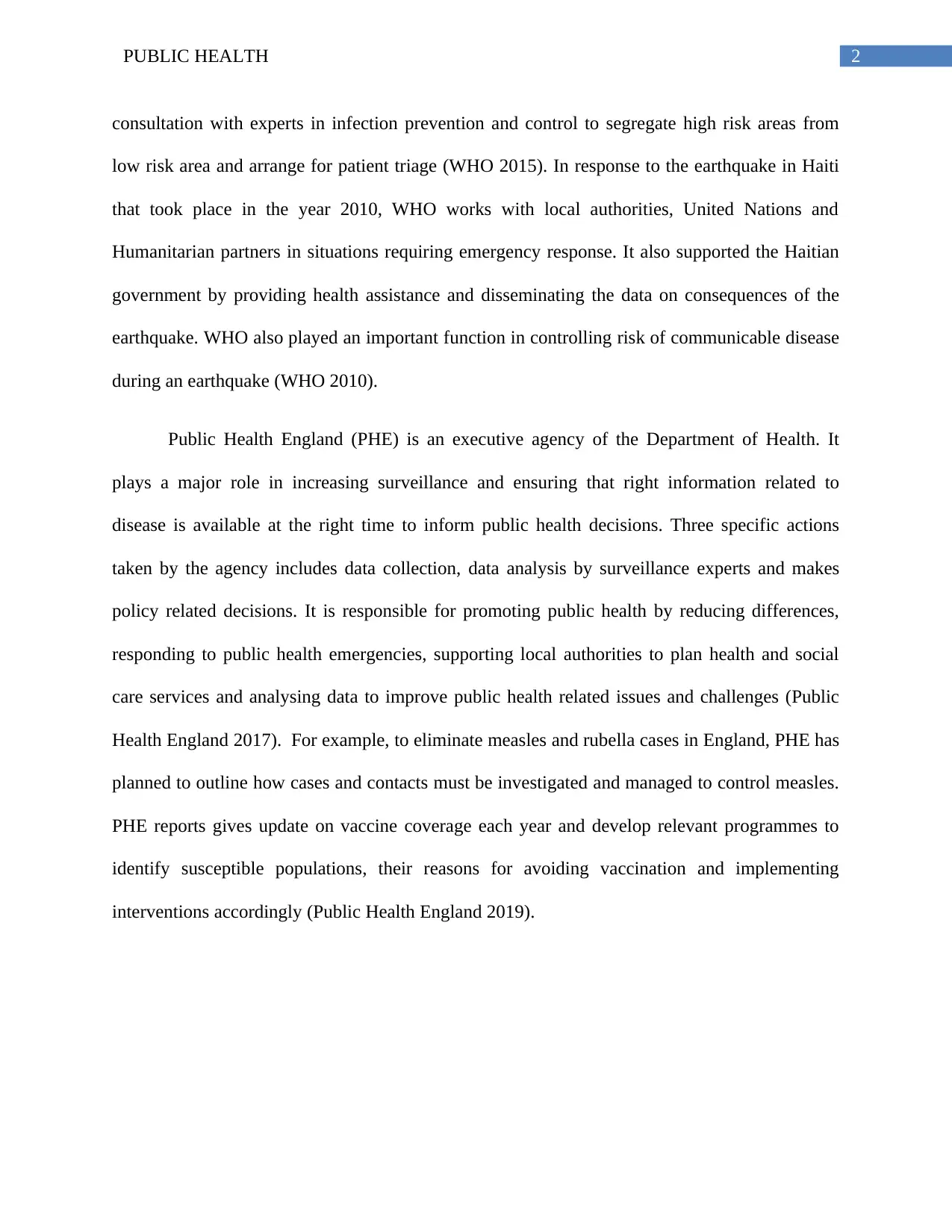
2PUBLIC HEALTH
consultation with experts in infection prevention and control to segregate high risk areas from
low risk area and arrange for patient triage (WHO 2015). In response to the earthquake in Haiti
that took place in the year 2010, WHO works with local authorities, United Nations and
Humanitarian partners in situations requiring emergency response. It also supported the Haitian
government by providing health assistance and disseminating the data on consequences of the
earthquake. WHO also played an important function in controlling risk of communicable disease
during an earthquake (WHO 2010).
Public Health England (PHE) is an executive agency of the Department of Health. It
plays a major role in increasing surveillance and ensuring that right information related to
disease is available at the right time to inform public health decisions. Three specific actions
taken by the agency includes data collection, data analysis by surveillance experts and makes
policy related decisions. It is responsible for promoting public health by reducing differences,
responding to public health emergencies, supporting local authorities to plan health and social
care services and analysing data to improve public health related issues and challenges (Public
Health England 2017). For example, to eliminate measles and rubella cases in England, PHE has
planned to outline how cases and contacts must be investigated and managed to control measles.
PHE reports gives update on vaccine coverage each year and develop relevant programmes to
identify susceptible populations, their reasons for avoiding vaccination and implementing
interventions accordingly (Public Health England 2019).
consultation with experts in infection prevention and control to segregate high risk areas from
low risk area and arrange for patient triage (WHO 2015). In response to the earthquake in Haiti
that took place in the year 2010, WHO works with local authorities, United Nations and
Humanitarian partners in situations requiring emergency response. It also supported the Haitian
government by providing health assistance and disseminating the data on consequences of the
earthquake. WHO also played an important function in controlling risk of communicable disease
during an earthquake (WHO 2010).
Public Health England (PHE) is an executive agency of the Department of Health. It
plays a major role in increasing surveillance and ensuring that right information related to
disease is available at the right time to inform public health decisions. Three specific actions
taken by the agency includes data collection, data analysis by surveillance experts and makes
policy related decisions. It is responsible for promoting public health by reducing differences,
responding to public health emergencies, supporting local authorities to plan health and social
care services and analysing data to improve public health related issues and challenges (Public
Health England 2017). For example, to eliminate measles and rubella cases in England, PHE has
planned to outline how cases and contacts must be investigated and managed to control measles.
PHE reports gives update on vaccine coverage each year and develop relevant programmes to
identify susceptible populations, their reasons for avoiding vaccination and implementing
interventions accordingly (Public Health England 2019).
⊘ This is a preview!⊘
Do you want full access?
Subscribe today to unlock all pages.

Trusted by 1+ million students worldwide
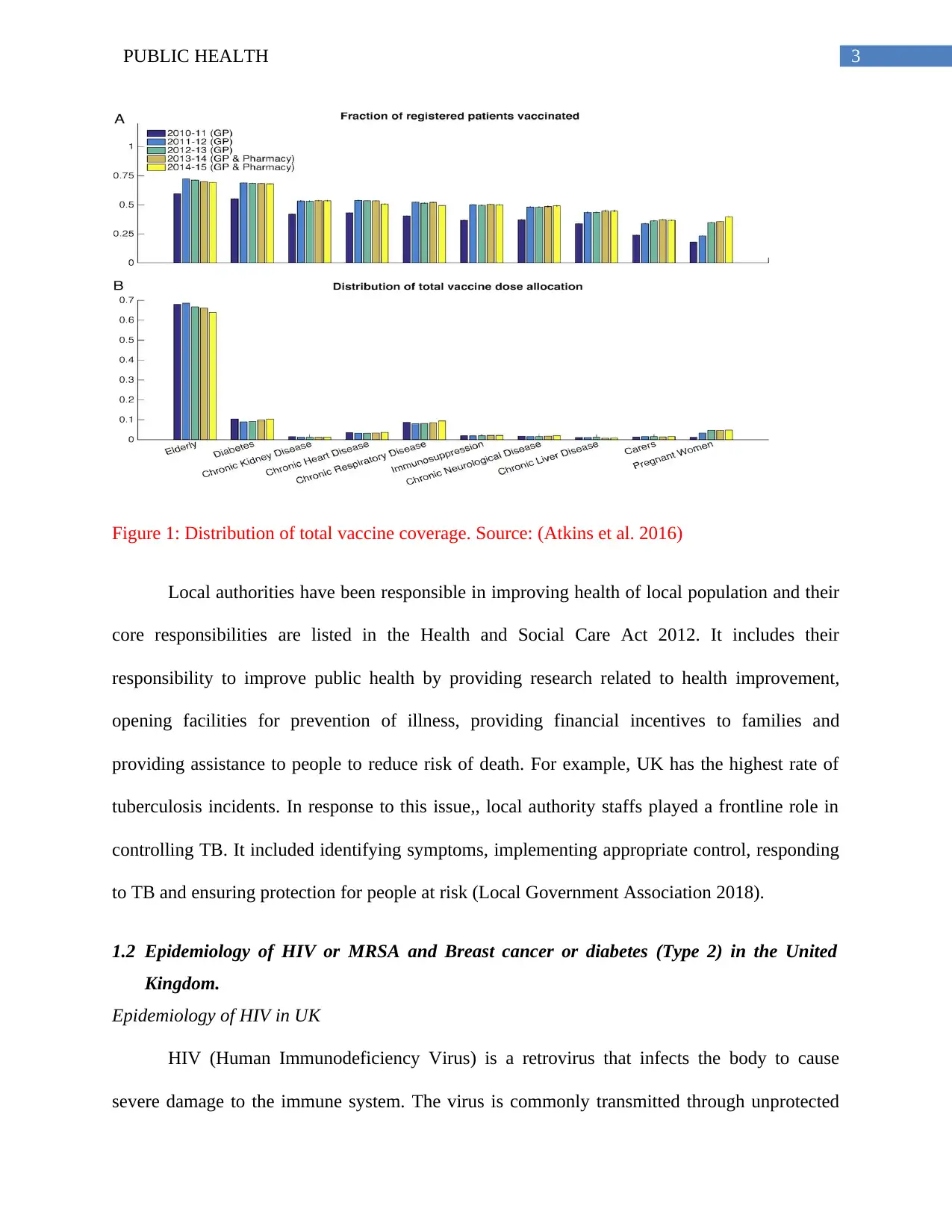
3PUBLIC HEALTH
Figure 1: Distribution of total vaccine coverage. Source: (Atkins et al. 2016)
Local authorities have been responsible in improving health of local population and their
core responsibilities are listed in the Health and Social Care Act 2012. It includes their
responsibility to improve public health by providing research related to health improvement,
opening facilities for prevention of illness, providing financial incentives to families and
providing assistance to people to reduce risk of death. For example, UK has the highest rate of
tuberculosis incidents. In response to this issue,, local authority staffs played a frontline role in
controlling TB. It included identifying symptoms, implementing appropriate control, responding
to TB and ensuring protection for people at risk (Local Government Association 2018).
1.2 Epidemiology of HIV or MRSA and Breast cancer or diabetes (Type 2) in the United
Kingdom.
Epidemiology of HIV in UK
HIV (Human Immunodeficiency Virus) is a retrovirus that infects the body to cause
severe damage to the immune system. The virus is commonly transmitted through unprotected
Figure 1: Distribution of total vaccine coverage. Source: (Atkins et al. 2016)
Local authorities have been responsible in improving health of local population and their
core responsibilities are listed in the Health and Social Care Act 2012. It includes their
responsibility to improve public health by providing research related to health improvement,
opening facilities for prevention of illness, providing financial incentives to families and
providing assistance to people to reduce risk of death. For example, UK has the highest rate of
tuberculosis incidents. In response to this issue,, local authority staffs played a frontline role in
controlling TB. It included identifying symptoms, implementing appropriate control, responding
to TB and ensuring protection for people at risk (Local Government Association 2018).
1.2 Epidemiology of HIV or MRSA and Breast cancer or diabetes (Type 2) in the United
Kingdom.
Epidemiology of HIV in UK
HIV (Human Immunodeficiency Virus) is a retrovirus that infects the body to cause
severe damage to the immune system. The virus is commonly transmitted through unprotected
Paraphrase This Document
Need a fresh take? Get an instant paraphrase of this document with our AI Paraphraser
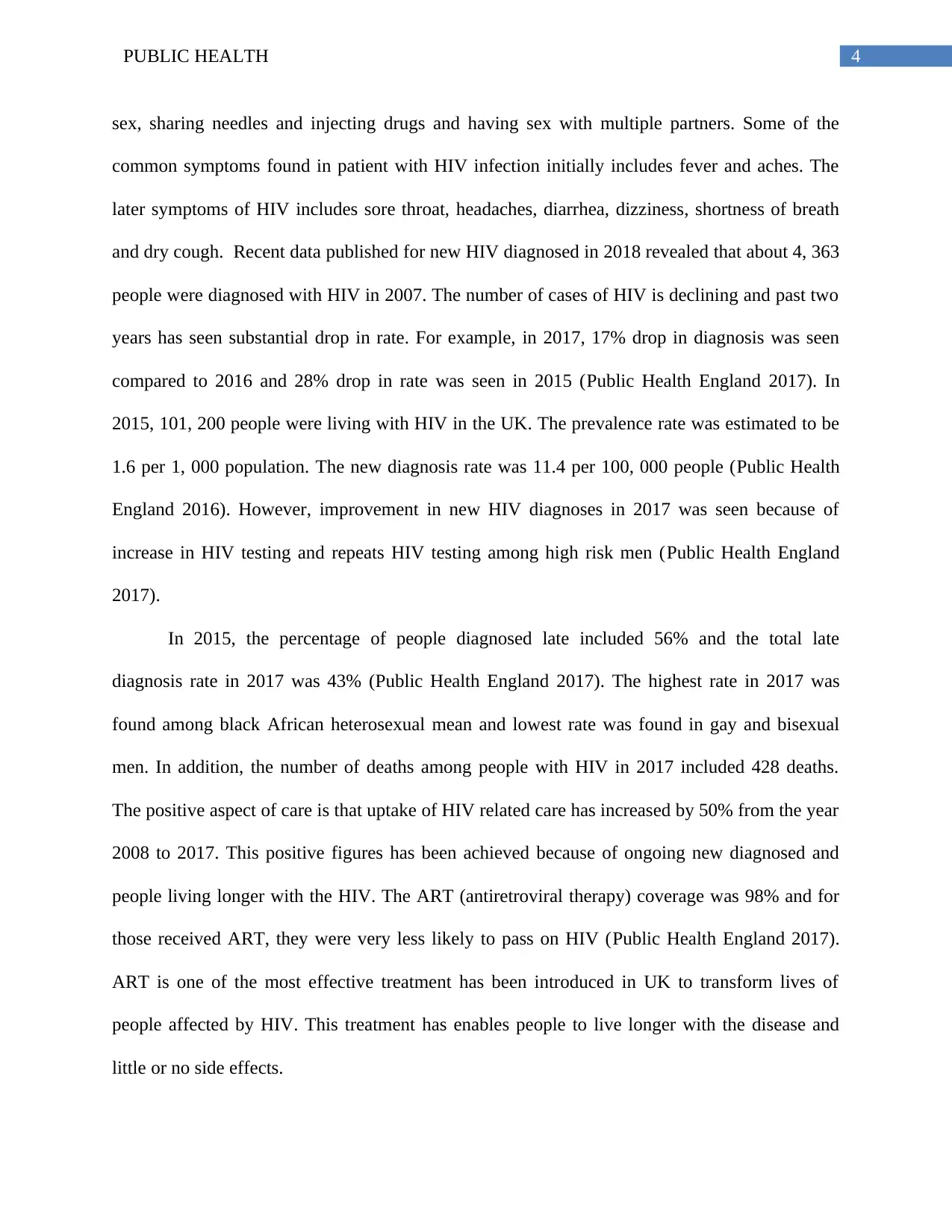
4PUBLIC HEALTH
sex, sharing needles and injecting drugs and having sex with multiple partners. Some of the
common symptoms found in patient with HIV infection initially includes fever and aches. The
later symptoms of HIV includes sore throat, headaches, diarrhea, dizziness, shortness of breath
and dry cough. Recent data published for new HIV diagnosed in 2018 revealed that about 4, 363
people were diagnosed with HIV in 2007. The number of cases of HIV is declining and past two
years has seen substantial drop in rate. For example, in 2017, 17% drop in diagnosis was seen
compared to 2016 and 28% drop in rate was seen in 2015 (Public Health England 2017). In
2015, 101, 200 people were living with HIV in the UK. The prevalence rate was estimated to be
1.6 per 1, 000 population. The new diagnosis rate was 11.4 per 100, 000 people (Public Health
England 2016). However, improvement in new HIV diagnoses in 2017 was seen because of
increase in HIV testing and repeats HIV testing among high risk men (Public Health England
2017).
In 2015, the percentage of people diagnosed late included 56% and the total late
diagnosis rate in 2017 was 43% (Public Health England 2017). The highest rate in 2017 was
found among black African heterosexual mean and lowest rate was found in gay and bisexual
men. In addition, the number of deaths among people with HIV in 2017 included 428 deaths.
The positive aspect of care is that uptake of HIV related care has increased by 50% from the year
2008 to 2017. This positive figures has been achieved because of ongoing new diagnosed and
people living longer with the HIV. The ART (antiretroviral therapy) coverage was 98% and for
those received ART, they were very less likely to pass on HIV (Public Health England 2017).
ART is one of the most effective treatment has been introduced in UK to transform lives of
people affected by HIV. This treatment has enables people to live longer with the disease and
little or no side effects.
sex, sharing needles and injecting drugs and having sex with multiple partners. Some of the
common symptoms found in patient with HIV infection initially includes fever and aches. The
later symptoms of HIV includes sore throat, headaches, diarrhea, dizziness, shortness of breath
and dry cough. Recent data published for new HIV diagnosed in 2018 revealed that about 4, 363
people were diagnosed with HIV in 2007. The number of cases of HIV is declining and past two
years has seen substantial drop in rate. For example, in 2017, 17% drop in diagnosis was seen
compared to 2016 and 28% drop in rate was seen in 2015 (Public Health England 2017). In
2015, 101, 200 people were living with HIV in the UK. The prevalence rate was estimated to be
1.6 per 1, 000 population. The new diagnosis rate was 11.4 per 100, 000 people (Public Health
England 2016). However, improvement in new HIV diagnoses in 2017 was seen because of
increase in HIV testing and repeats HIV testing among high risk men (Public Health England
2017).
In 2015, the percentage of people diagnosed late included 56% and the total late
diagnosis rate in 2017 was 43% (Public Health England 2017). The highest rate in 2017 was
found among black African heterosexual mean and lowest rate was found in gay and bisexual
men. In addition, the number of deaths among people with HIV in 2017 included 428 deaths.
The positive aspect of care is that uptake of HIV related care has increased by 50% from the year
2008 to 2017. This positive figures has been achieved because of ongoing new diagnosed and
people living longer with the HIV. The ART (antiretroviral therapy) coverage was 98% and for
those received ART, they were very less likely to pass on HIV (Public Health England 2017).
ART is one of the most effective treatment has been introduced in UK to transform lives of
people affected by HIV. This treatment has enables people to live longer with the disease and
little or no side effects.
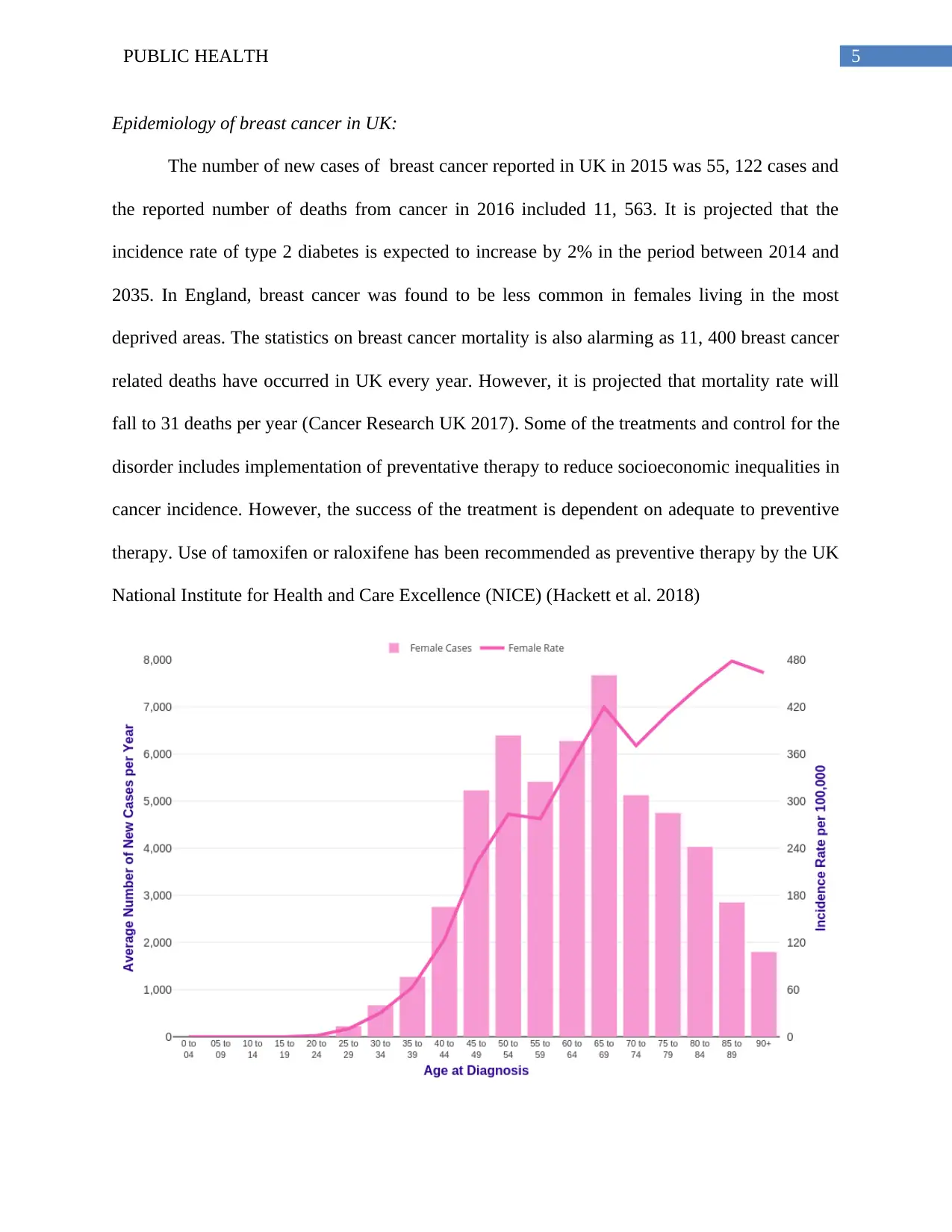
5PUBLIC HEALTH
Epidemiology of breast cancer in UK:
The number of new cases of breast cancer reported in UK in 2015 was 55, 122 cases and
the reported number of deaths from cancer in 2016 included 11, 563. It is projected that the
incidence rate of type 2 diabetes is expected to increase by 2% in the period between 2014 and
2035. In England, breast cancer was found to be less common in females living in the most
deprived areas. The statistics on breast cancer mortality is also alarming as 11, 400 breast cancer
related deaths have occurred in UK every year. However, it is projected that mortality rate will
fall to 31 deaths per year (Cancer Research UK 2017). Some of the treatments and control for the
disorder includes implementation of preventative therapy to reduce socioeconomic inequalities in
cancer incidence. However, the success of the treatment is dependent on adequate to preventive
therapy. Use of tamoxifen or raloxifene has been recommended as preventive therapy by the UK
National Institute for Health and Care Excellence (NICE) (Hackett et al. 2018)
Epidemiology of breast cancer in UK:
The number of new cases of breast cancer reported in UK in 2015 was 55, 122 cases and
the reported number of deaths from cancer in 2016 included 11, 563. It is projected that the
incidence rate of type 2 diabetes is expected to increase by 2% in the period between 2014 and
2035. In England, breast cancer was found to be less common in females living in the most
deprived areas. The statistics on breast cancer mortality is also alarming as 11, 400 breast cancer
related deaths have occurred in UK every year. However, it is projected that mortality rate will
fall to 31 deaths per year (Cancer Research UK 2017). Some of the treatments and control for the
disorder includes implementation of preventative therapy to reduce socioeconomic inequalities in
cancer incidence. However, the success of the treatment is dependent on adequate to preventive
therapy. Use of tamoxifen or raloxifene has been recommended as preventive therapy by the UK
National Institute for Health and Care Excellence (NICE) (Hackett et al. 2018)
⊘ This is a preview!⊘
Do you want full access?
Subscribe today to unlock all pages.

Trusted by 1+ million students worldwide
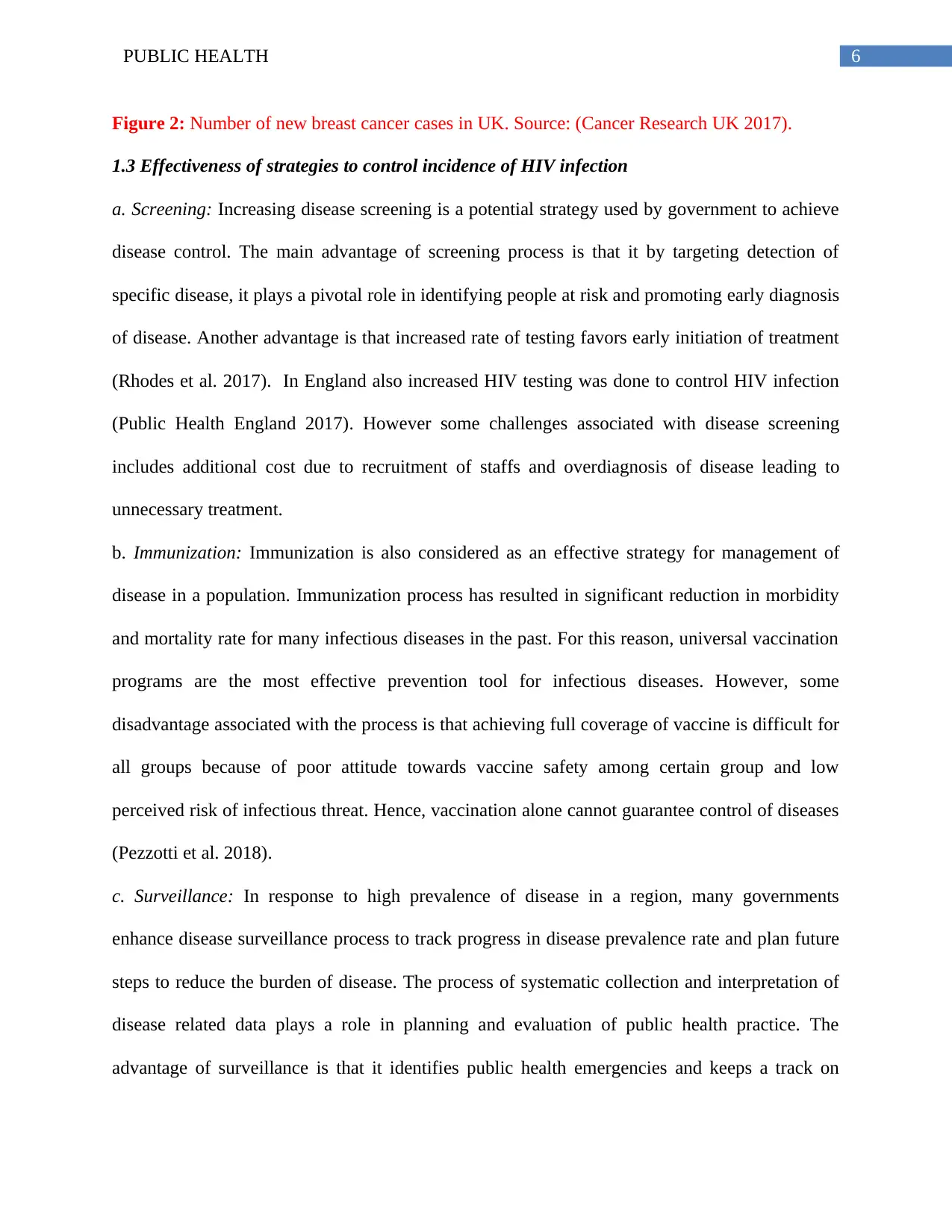
6PUBLIC HEALTH
Figure 2: Number of new breast cancer cases in UK. Source: (Cancer Research UK 2017).
1.3 Effectiveness of strategies to control incidence of HIV infection
a. Screening: Increasing disease screening is a potential strategy used by government to achieve
disease control. The main advantage of screening process is that it by targeting detection of
specific disease, it plays a pivotal role in identifying people at risk and promoting early diagnosis
of disease. Another advantage is that increased rate of testing favors early initiation of treatment
(Rhodes et al. 2017). In England also increased HIV testing was done to control HIV infection
(Public Health England 2017). However some challenges associated with disease screening
includes additional cost due to recruitment of staffs and overdiagnosis of disease leading to
unnecessary treatment.
b. Immunization: Immunization is also considered as an effective strategy for management of
disease in a population. Immunization process has resulted in significant reduction in morbidity
and mortality rate for many infectious diseases in the past. For this reason, universal vaccination
programs are the most effective prevention tool for infectious diseases. However, some
disadvantage associated with the process is that achieving full coverage of vaccine is difficult for
all groups because of poor attitude towards vaccine safety among certain group and low
perceived risk of infectious threat. Hence, vaccination alone cannot guarantee control of diseases
(Pezzotti et al. 2018).
c. Surveillance: In response to high prevalence of disease in a region, many governments
enhance disease surveillance process to track progress in disease prevalence rate and plan future
steps to reduce the burden of disease. The process of systematic collection and interpretation of
disease related data plays a role in planning and evaluation of public health practice. The
advantage of surveillance is that it identifies public health emergencies and keeps a track on
Figure 2: Number of new breast cancer cases in UK. Source: (Cancer Research UK 2017).
1.3 Effectiveness of strategies to control incidence of HIV infection
a. Screening: Increasing disease screening is a potential strategy used by government to achieve
disease control. The main advantage of screening process is that it by targeting detection of
specific disease, it plays a pivotal role in identifying people at risk and promoting early diagnosis
of disease. Another advantage is that increased rate of testing favors early initiation of treatment
(Rhodes et al. 2017). In England also increased HIV testing was done to control HIV infection
(Public Health England 2017). However some challenges associated with disease screening
includes additional cost due to recruitment of staffs and overdiagnosis of disease leading to
unnecessary treatment.
b. Immunization: Immunization is also considered as an effective strategy for management of
disease in a population. Immunization process has resulted in significant reduction in morbidity
and mortality rate for many infectious diseases in the past. For this reason, universal vaccination
programs are the most effective prevention tool for infectious diseases. However, some
disadvantage associated with the process is that achieving full coverage of vaccine is difficult for
all groups because of poor attitude towards vaccine safety among certain group and low
perceived risk of infectious threat. Hence, vaccination alone cannot guarantee control of diseases
(Pezzotti et al. 2018).
c. Surveillance: In response to high prevalence of disease in a region, many governments
enhance disease surveillance process to track progress in disease prevalence rate and plan future
steps to reduce the burden of disease. The process of systematic collection and interpretation of
disease related data plays a role in planning and evaluation of public health practice. The
advantage of surveillance is that it identifies public health emergencies and keeps a track on
Paraphrase This Document
Need a fresh take? Get an instant paraphrase of this document with our AI Paraphraser
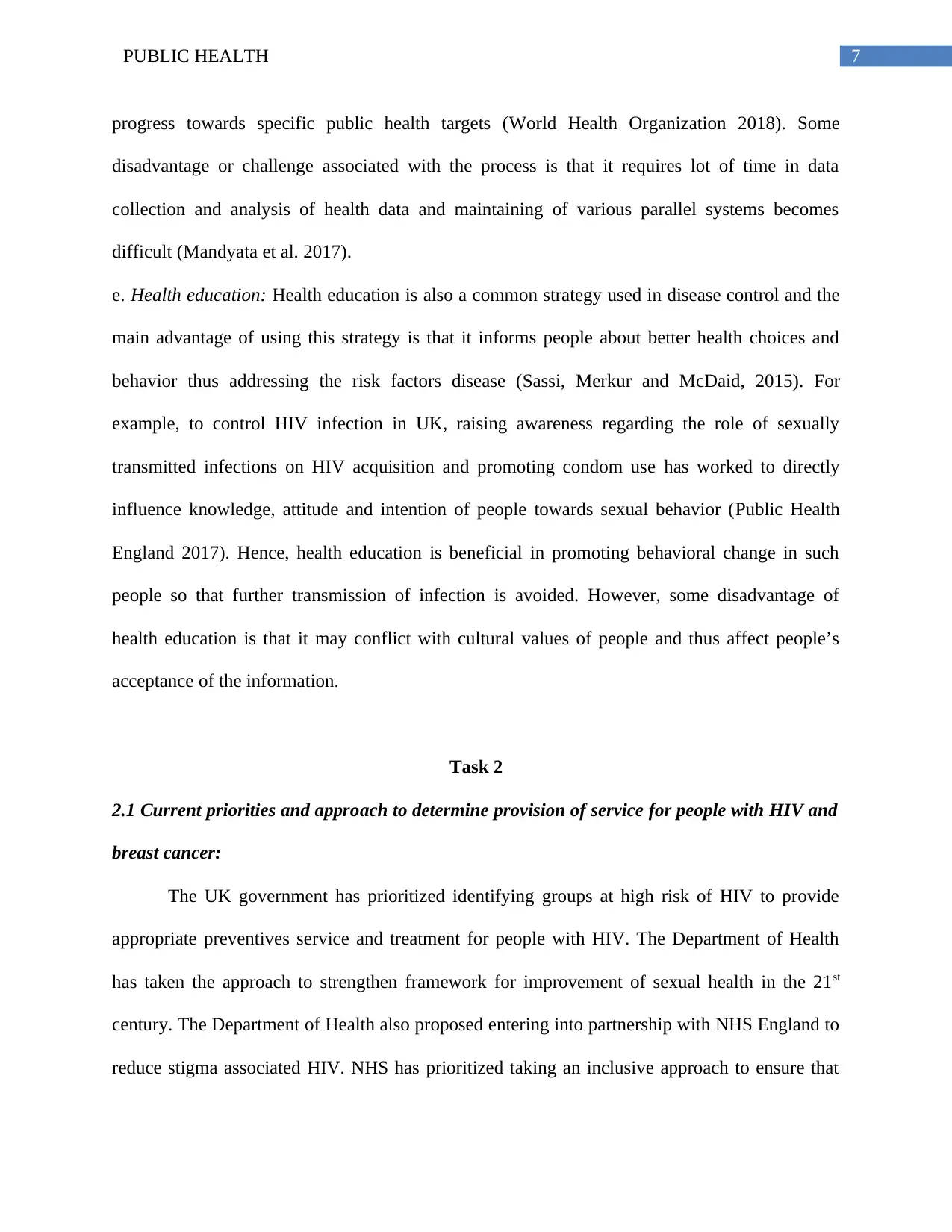
7PUBLIC HEALTH
progress towards specific public health targets (World Health Organization 2018). Some
disadvantage or challenge associated with the process is that it requires lot of time in data
collection and analysis of health data and maintaining of various parallel systems becomes
difficult (Mandyata et al. 2017).
e. Health education: Health education is also a common strategy used in disease control and the
main advantage of using this strategy is that it informs people about better health choices and
behavior thus addressing the risk factors disease (Sassi, Merkur and McDaid, 2015). For
example, to control HIV infection in UK, raising awareness regarding the role of sexually
transmitted infections on HIV acquisition and promoting condom use has worked to directly
influence knowledge, attitude and intention of people towards sexual behavior (Public Health
England 2017). Hence, health education is beneficial in promoting behavioral change in such
people so that further transmission of infection is avoided. However, some disadvantage of
health education is that it may conflict with cultural values of people and thus affect people’s
acceptance of the information.
Task 2
2.1 Current priorities and approach to determine provision of service for people with HIV and
breast cancer:
The UK government has prioritized identifying groups at high risk of HIV to provide
appropriate preventives service and treatment for people with HIV. The Department of Health
has taken the approach to strengthen framework for improvement of sexual health in the 21st
century. The Department of Health also proposed entering into partnership with NHS England to
reduce stigma associated HIV. NHS has prioritized taking an inclusive approach to ensure that
progress towards specific public health targets (World Health Organization 2018). Some
disadvantage or challenge associated with the process is that it requires lot of time in data
collection and analysis of health data and maintaining of various parallel systems becomes
difficult (Mandyata et al. 2017).
e. Health education: Health education is also a common strategy used in disease control and the
main advantage of using this strategy is that it informs people about better health choices and
behavior thus addressing the risk factors disease (Sassi, Merkur and McDaid, 2015). For
example, to control HIV infection in UK, raising awareness regarding the role of sexually
transmitted infections on HIV acquisition and promoting condom use has worked to directly
influence knowledge, attitude and intention of people towards sexual behavior (Public Health
England 2017). Hence, health education is beneficial in promoting behavioral change in such
people so that further transmission of infection is avoided. However, some disadvantage of
health education is that it may conflict with cultural values of people and thus affect people’s
acceptance of the information.
Task 2
2.1 Current priorities and approach to determine provision of service for people with HIV and
breast cancer:
The UK government has prioritized identifying groups at high risk of HIV to provide
appropriate preventives service and treatment for people with HIV. The Department of Health
has taken the approach to strengthen framework for improvement of sexual health in the 21st
century. The Department of Health also proposed entering into partnership with NHS England to
reduce stigma associated HIV. NHS has prioritized taking an inclusive approach to ensure that
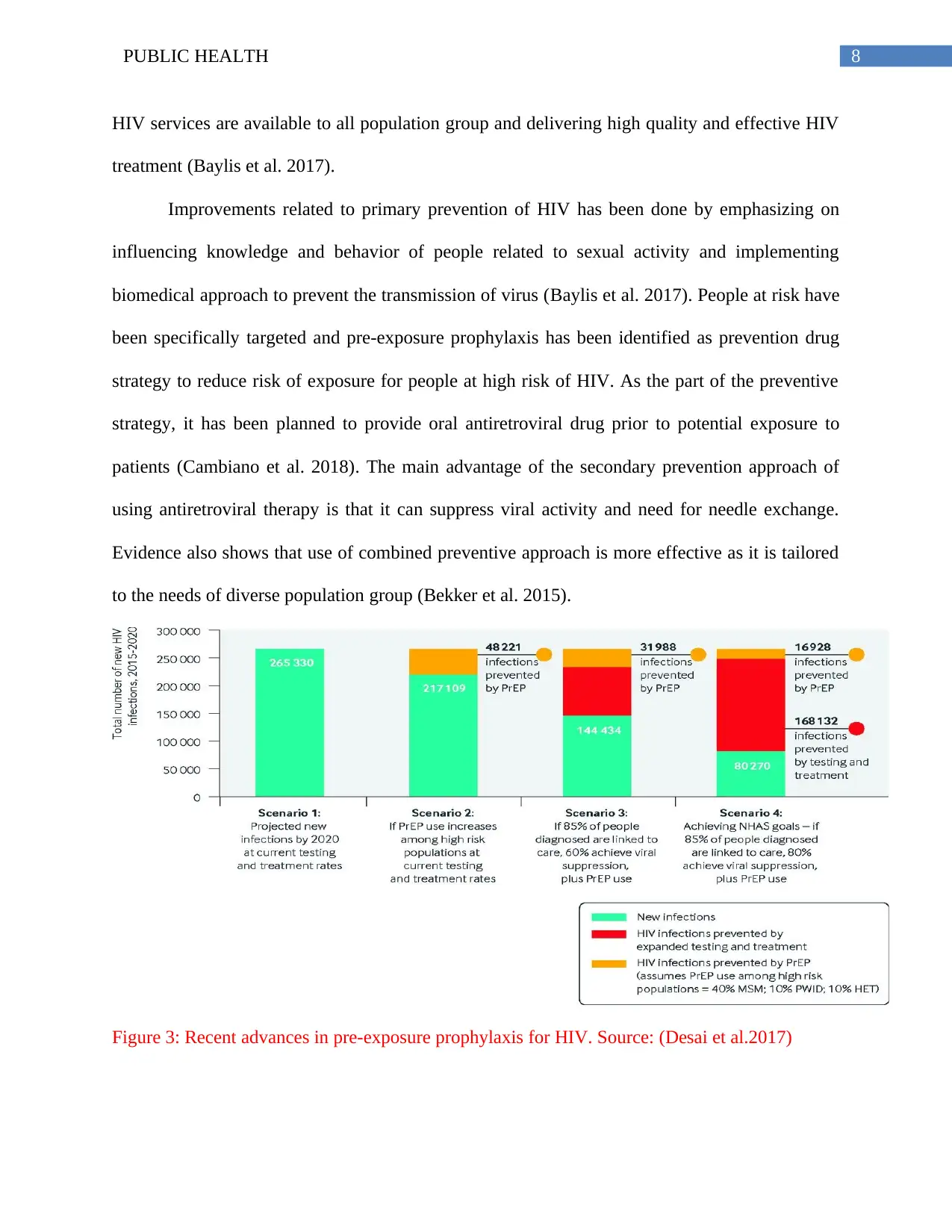
8PUBLIC HEALTH
HIV services are available to all population group and delivering high quality and effective HIV
treatment (Baylis et al. 2017).
Improvements related to primary prevention of HIV has been done by emphasizing on
influencing knowledge and behavior of people related to sexual activity and implementing
biomedical approach to prevent the transmission of virus (Baylis et al. 2017). People at risk have
been specifically targeted and pre-exposure prophylaxis has been identified as prevention drug
strategy to reduce risk of exposure for people at high risk of HIV. As the part of the preventive
strategy, it has been planned to provide oral antiretroviral drug prior to potential exposure to
patients (Cambiano et al. 2018). The main advantage of the secondary prevention approach of
using antiretroviral therapy is that it can suppress viral activity and need for needle exchange.
Evidence also shows that use of combined preventive approach is more effective as it is tailored
to the needs of diverse population group (Bekker et al. 2015).
Figure 3: Recent advances in pre-exposure prophylaxis for HIV. Source: (Desai et al.2017)
HIV services are available to all population group and delivering high quality and effective HIV
treatment (Baylis et al. 2017).
Improvements related to primary prevention of HIV has been done by emphasizing on
influencing knowledge and behavior of people related to sexual activity and implementing
biomedical approach to prevent the transmission of virus (Baylis et al. 2017). People at risk have
been specifically targeted and pre-exposure prophylaxis has been identified as prevention drug
strategy to reduce risk of exposure for people at high risk of HIV. As the part of the preventive
strategy, it has been planned to provide oral antiretroviral drug prior to potential exposure to
patients (Cambiano et al. 2018). The main advantage of the secondary prevention approach of
using antiretroviral therapy is that it can suppress viral activity and need for needle exchange.
Evidence also shows that use of combined preventive approach is more effective as it is tailored
to the needs of diverse population group (Bekker et al. 2015).
Figure 3: Recent advances in pre-exposure prophylaxis for HIV. Source: (Desai et al.2017)
⊘ This is a preview!⊘
Do you want full access?
Subscribe today to unlock all pages.

Trusted by 1+ million students worldwide
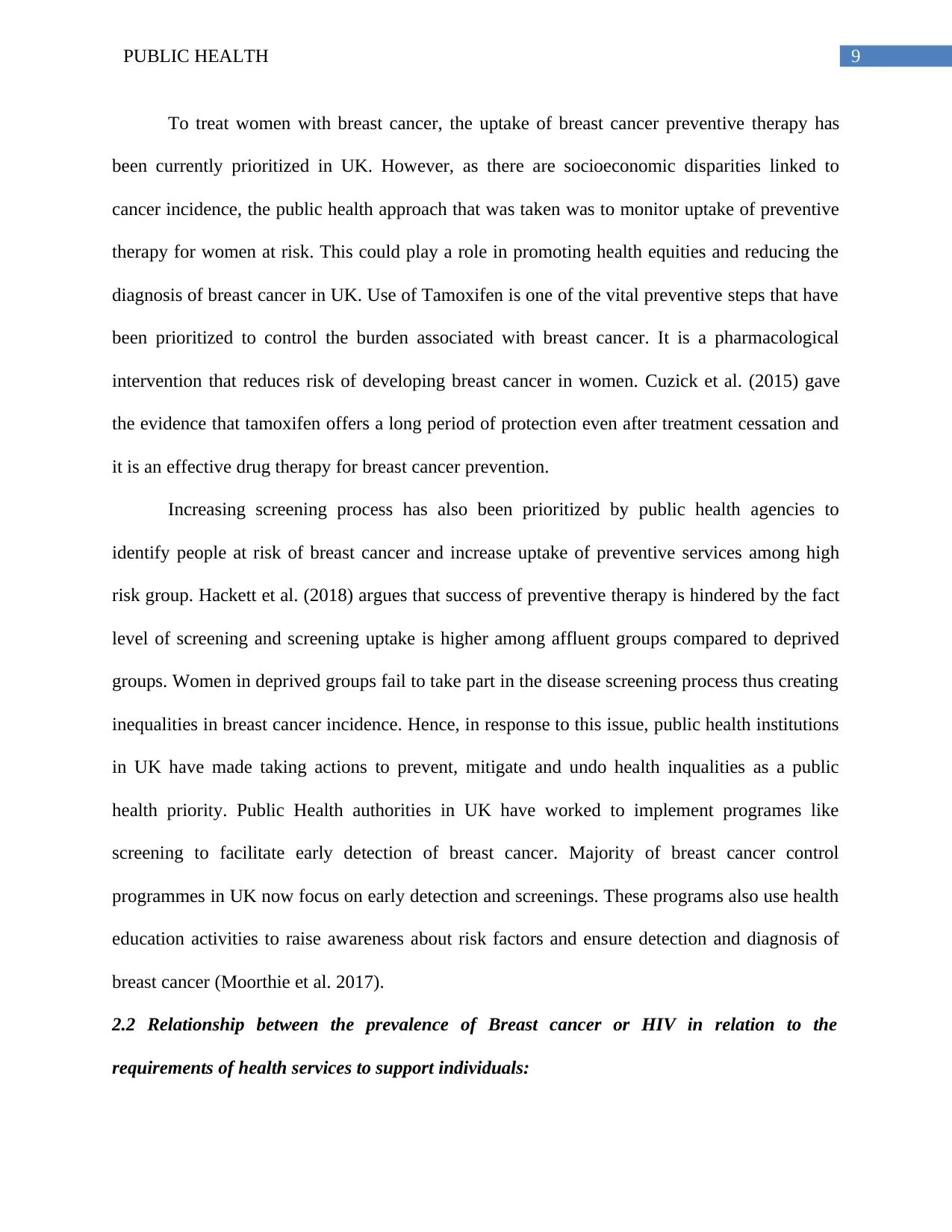
9PUBLIC HEALTH
To treat women with breast cancer, the uptake of breast cancer preventive therapy has
been currently prioritized in UK. However, as there are socioeconomic disparities linked to
cancer incidence, the public health approach that was taken was to monitor uptake of preventive
therapy for women at risk. This could play a role in promoting health equities and reducing the
diagnosis of breast cancer in UK. Use of Tamoxifen is one of the vital preventive steps that have
been prioritized to control the burden associated with breast cancer. It is a pharmacological
intervention that reduces risk of developing breast cancer in women. Cuzick et al. (2015) gave
the evidence that tamoxifen offers a long period of protection even after treatment cessation and
it is an effective drug therapy for breast cancer prevention.
Increasing screening process has also been prioritized by public health agencies to
identify people at risk of breast cancer and increase uptake of preventive services among high
risk group. Hackett et al. (2018) argues that success of preventive therapy is hindered by the fact
level of screening and screening uptake is higher among affluent groups compared to deprived
groups. Women in deprived groups fail to take part in the disease screening process thus creating
inequalities in breast cancer incidence. Hence, in response to this issue, public health institutions
in UK have made taking actions to prevent, mitigate and undo health inqualities as a public
health priority. Public Health authorities in UK have worked to implement programes like
screening to facilitate early detection of breast cancer. Majority of breast cancer control
programmes in UK now focus on early detection and screenings. These programs also use health
education activities to raise awareness about risk factors and ensure detection and diagnosis of
breast cancer (Moorthie et al. 2017).
2.2 Relationship between the prevalence of Breast cancer or HIV in relation to the
requirements of health services to support individuals:
To treat women with breast cancer, the uptake of breast cancer preventive therapy has
been currently prioritized in UK. However, as there are socioeconomic disparities linked to
cancer incidence, the public health approach that was taken was to monitor uptake of preventive
therapy for women at risk. This could play a role in promoting health equities and reducing the
diagnosis of breast cancer in UK. Use of Tamoxifen is one of the vital preventive steps that have
been prioritized to control the burden associated with breast cancer. It is a pharmacological
intervention that reduces risk of developing breast cancer in women. Cuzick et al. (2015) gave
the evidence that tamoxifen offers a long period of protection even after treatment cessation and
it is an effective drug therapy for breast cancer prevention.
Increasing screening process has also been prioritized by public health agencies to
identify people at risk of breast cancer and increase uptake of preventive services among high
risk group. Hackett et al. (2018) argues that success of preventive therapy is hindered by the fact
level of screening and screening uptake is higher among affluent groups compared to deprived
groups. Women in deprived groups fail to take part in the disease screening process thus creating
inequalities in breast cancer incidence. Hence, in response to this issue, public health institutions
in UK have made taking actions to prevent, mitigate and undo health inqualities as a public
health priority. Public Health authorities in UK have worked to implement programes like
screening to facilitate early detection of breast cancer. Majority of breast cancer control
programmes in UK now focus on early detection and screenings. These programs also use health
education activities to raise awareness about risk factors and ensure detection and diagnosis of
breast cancer (Moorthie et al. 2017).
2.2 Relationship between the prevalence of Breast cancer or HIV in relation to the
requirements of health services to support individuals:
Paraphrase This Document
Need a fresh take? Get an instant paraphrase of this document with our AI Paraphraser
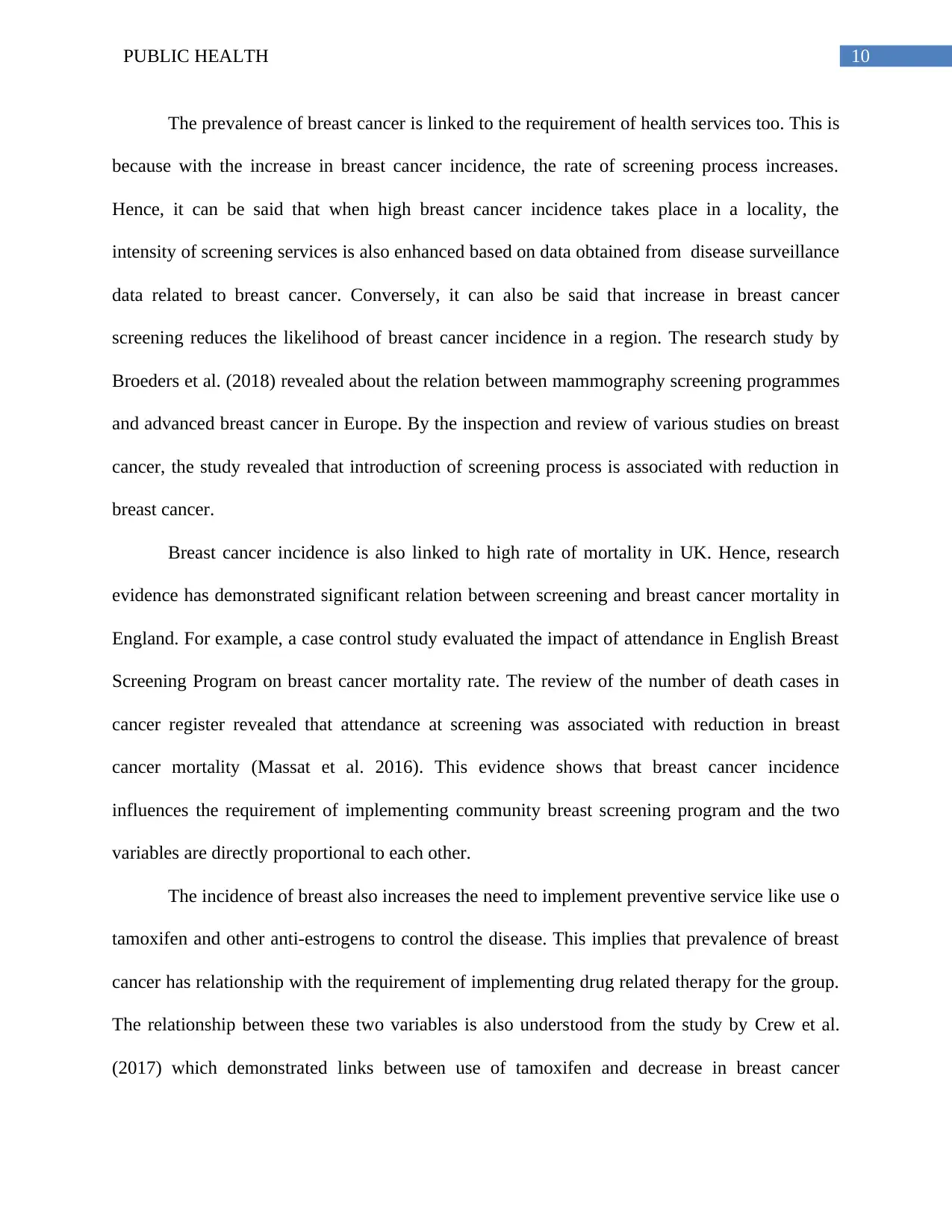
10PUBLIC HEALTH
The prevalence of breast cancer is linked to the requirement of health services too. This is
because with the increase in breast cancer incidence, the rate of screening process increases.
Hence, it can be said that when high breast cancer incidence takes place in a locality, the
intensity of screening services is also enhanced based on data obtained from disease surveillance
data related to breast cancer. Conversely, it can also be said that increase in breast cancer
screening reduces the likelihood of breast cancer incidence in a region. The research study by
Broeders et al. (2018) revealed about the relation between mammography screening programmes
and advanced breast cancer in Europe. By the inspection and review of various studies on breast
cancer, the study revealed that introduction of screening process is associated with reduction in
breast cancer.
Breast cancer incidence is also linked to high rate of mortality in UK. Hence, research
evidence has demonstrated significant relation between screening and breast cancer mortality in
England. For example, a case control study evaluated the impact of attendance in English Breast
Screening Program on breast cancer mortality rate. The review of the number of death cases in
cancer register revealed that attendance at screening was associated with reduction in breast
cancer mortality (Massat et al. 2016). This evidence shows that breast cancer incidence
influences the requirement of implementing community breast screening program and the two
variables are directly proportional to each other.
The incidence of breast also increases the need to implement preventive service like use o
tamoxifen and other anti-estrogens to control the disease. This implies that prevalence of breast
cancer has relationship with the requirement of implementing drug related therapy for the group.
The relationship between these two variables is also understood from the study by Crew et al.
(2017) which demonstrated links between use of tamoxifen and decrease in breast cancer
The prevalence of breast cancer is linked to the requirement of health services too. This is
because with the increase in breast cancer incidence, the rate of screening process increases.
Hence, it can be said that when high breast cancer incidence takes place in a locality, the
intensity of screening services is also enhanced based on data obtained from disease surveillance
data related to breast cancer. Conversely, it can also be said that increase in breast cancer
screening reduces the likelihood of breast cancer incidence in a region. The research study by
Broeders et al. (2018) revealed about the relation between mammography screening programmes
and advanced breast cancer in Europe. By the inspection and review of various studies on breast
cancer, the study revealed that introduction of screening process is associated with reduction in
breast cancer.
Breast cancer incidence is also linked to high rate of mortality in UK. Hence, research
evidence has demonstrated significant relation between screening and breast cancer mortality in
England. For example, a case control study evaluated the impact of attendance in English Breast
Screening Program on breast cancer mortality rate. The review of the number of death cases in
cancer register revealed that attendance at screening was associated with reduction in breast
cancer mortality (Massat et al. 2016). This evidence shows that breast cancer incidence
influences the requirement of implementing community breast screening program and the two
variables are directly proportional to each other.
The incidence of breast also increases the need to implement preventive service like use o
tamoxifen and other anti-estrogens to control the disease. This implies that prevalence of breast
cancer has relationship with the requirement of implementing drug related therapy for the group.
The relationship between these two variables is also understood from the study by Crew et al.
(2017) which demonstrated links between use of tamoxifen and decrease in breast cancer
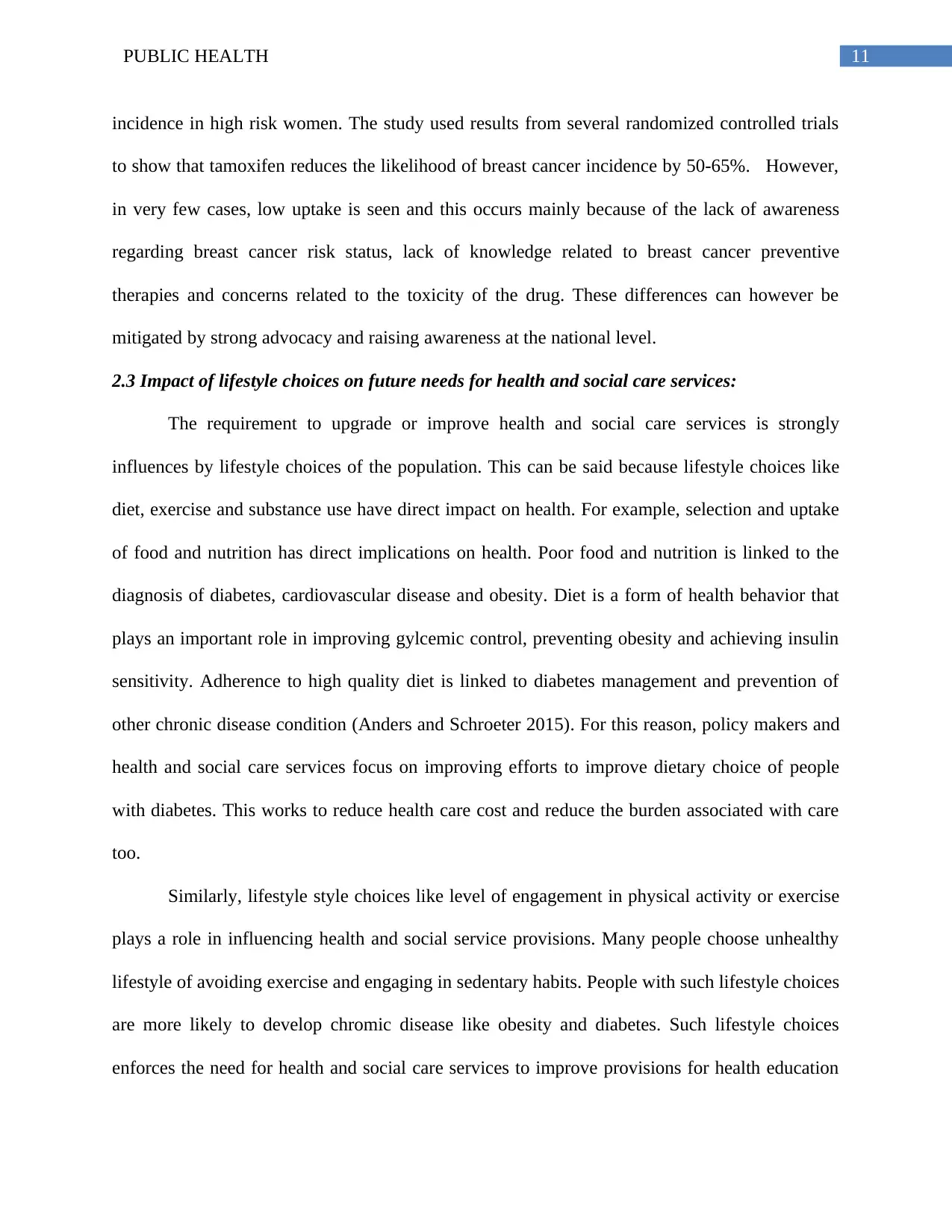
11PUBLIC HEALTH
incidence in high risk women. The study used results from several randomized controlled trials
to show that tamoxifen reduces the likelihood of breast cancer incidence by 50-65%. However,
in very few cases, low uptake is seen and this occurs mainly because of the lack of awareness
regarding breast cancer risk status, lack of knowledge related to breast cancer preventive
therapies and concerns related to the toxicity of the drug. These differences can however be
mitigated by strong advocacy and raising awareness at the national level.
2.3 Impact of lifestyle choices on future needs for health and social care services:
The requirement to upgrade or improve health and social care services is strongly
influences by lifestyle choices of the population. This can be said because lifestyle choices like
diet, exercise and substance use have direct impact on health. For example, selection and uptake
of food and nutrition has direct implications on health. Poor food and nutrition is linked to the
diagnosis of diabetes, cardiovascular disease and obesity. Diet is a form of health behavior that
plays an important role in improving gylcemic control, preventing obesity and achieving insulin
sensitivity. Adherence to high quality diet is linked to diabetes management and prevention of
other chronic disease condition (Anders and Schroeter 2015). For this reason, policy makers and
health and social care services focus on improving efforts to improve dietary choice of people
with diabetes. This works to reduce health care cost and reduce the burden associated with care
too.
Similarly, lifestyle style choices like level of engagement in physical activity or exercise
plays a role in influencing health and social service provisions. Many people choose unhealthy
lifestyle of avoiding exercise and engaging in sedentary habits. People with such lifestyle choices
are more likely to develop chromic disease like obesity and diabetes. Such lifestyle choices
enforces the need for health and social care services to improve provisions for health education
incidence in high risk women. The study used results from several randomized controlled trials
to show that tamoxifen reduces the likelihood of breast cancer incidence by 50-65%. However,
in very few cases, low uptake is seen and this occurs mainly because of the lack of awareness
regarding breast cancer risk status, lack of knowledge related to breast cancer preventive
therapies and concerns related to the toxicity of the drug. These differences can however be
mitigated by strong advocacy and raising awareness at the national level.
2.3 Impact of lifestyle choices on future needs for health and social care services:
The requirement to upgrade or improve health and social care services is strongly
influences by lifestyle choices of the population. This can be said because lifestyle choices like
diet, exercise and substance use have direct impact on health. For example, selection and uptake
of food and nutrition has direct implications on health. Poor food and nutrition is linked to the
diagnosis of diabetes, cardiovascular disease and obesity. Diet is a form of health behavior that
plays an important role in improving gylcemic control, preventing obesity and achieving insulin
sensitivity. Adherence to high quality diet is linked to diabetes management and prevention of
other chronic disease condition (Anders and Schroeter 2015). For this reason, policy makers and
health and social care services focus on improving efforts to improve dietary choice of people
with diabetes. This works to reduce health care cost and reduce the burden associated with care
too.
Similarly, lifestyle style choices like level of engagement in physical activity or exercise
plays a role in influencing health and social service provisions. Many people choose unhealthy
lifestyle of avoiding exercise and engaging in sedentary habits. People with such lifestyle choices
are more likely to develop chromic disease like obesity and diabetes. Such lifestyle choices
enforces the need for health and social care services to improve provisions for health education
⊘ This is a preview!⊘
Do you want full access?
Subscribe today to unlock all pages.

Trusted by 1+ million students worldwide
1 out of 24
Related Documents
Your All-in-One AI-Powered Toolkit for Academic Success.
+13062052269
info@desklib.com
Available 24*7 on WhatsApp / Email
![[object Object]](/_next/static/media/star-bottom.7253800d.svg)
Unlock your academic potential
Copyright © 2020–2025 A2Z Services. All Rights Reserved. Developed and managed by ZUCOL.





